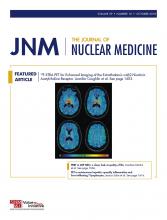Women, nuclear medicine, and cancer risk: Siegel and colleagues critique assumptions behind a recent article in the radiology literature on risks associated with nuclear medicine radiation doses in women.
Page 1489
Response to Siegel et al.: Biegon and colleagues reply to an article in this issue of JNM and emphasize the need to consider sex as a factor in considering radiation risk associated with nuclear medicine imaging.
Page 1491
Right-to-Try Law: Brown and colleagues review the pros and cons of this 2018 legislation allowing use of experimental, non-FDA–approved drugs as a last resort for those unable to participate in clinical testing and with no remaining treatment options.
Page 1492
Dosimetry relevance: Lassmann and Eberlein provide an overview of the most recent developments in state-of-the-art equipment for dosimetry in radionuclide therapies, including calibration methods for imaging, small-scale dosimetry, and limitations of patient-specific dosimetry.
Page 1494
Radiometals for PET: Brandt and colleagues present the second in a series of continuing education reviews, focusing here on general aspects of radiometal-based PET radiotracers and the most frequently applied metallic PET radionuclides: 68Ga, 89Zr, and 64Cu.
Page 1500
Biodistribution reporting: Kesner and Bodei provide an editorial emphasizing the importance of treating biodistribution measurements as a valuable part of dosimetry work that is worthy of robust documentation.
Page 1507
131I SPECT/CT in PTMC follow-up: Spanu and colleagues assess the diagnostic role of 131I SPECT/CT in detecting metastases in patients with papillary thyroid microcarcinomas over the course of long-term follow-up.
Page 1510
18F-FDHT PET/CT reproducibility: Vargas and colleagues describe PET/CT reproducibility and repeatability with this radiolabeled analog of the androgen receptor’s primary ligand in men with metastatic castration-resistant prostate cancer.
Page 1516
PET response, skeletal lesions, and pediatric HL: Georgi and colleagues explore the suitability of current 18F-FDG PET response criteria for skeletal involvement in Hodgkin lymphoma and compare initial uptake intensity/metabolic tumor volumes with PET response after 2 cycles of chemotherapy.
Page 1524
Imaging CAR T cells with 89Zr-oxine: Weist and colleagues optimize 89Zr-oxine labeling of chimeric antigen receptor T cells and evaluate PET as a platform for imaging adoptively transferred CAR T cells.
Page 1531
SHBG and 18F-FDHT accumulation: Larimer and colleagues elucidate the role of the sex hormone–binding globulin in developing a model of rodent androgen receptor PET imaging, with a goal of noninvasively interrogating androgen expression over time in murine models.
Page 1538
Dexamethasone and NSCLC: McHugh and colleagues assess the potential of 18F-FLT PET monitoring of dexamethasone-mediated S-phase suppression in non–small cell lung cancer as a means to individualize pemetrexed chemotherapy.
Page 1544
Imaging melphalan therapy response: Hathi and colleagues determine the utility of 8F-FDOPA, which mediates uptake of melphalan (a small-molecule DNA-alkylating agent), for imaging melphalan therapy response in a preclinical model of multiple myeloma.
Page 1551
Preclinical 18F-FLT and 18F-ICMT-11 PET: Heinzmann and colleagues evaluate these tracers in detection of early treatment-induced changes in tumor biology and determine whether these changes indicate a response to cetuximab administered as monotherapy or in combination with gemcitabine.
Page 1558
QoL and PRRT for NETs: Martini and colleagues evaluate quality-of-life factors in patients with gastroenteropancreatic neuroendocrine tumors from first peptide-receptor radionuclide therapy to first restaging and compare resulting scores with general population norms.
Page 1566
Simplified dynamic 123I-MIBG SPECT: Wu and colleagues report on a simplified quantification method for dynamic 123I-MIBG SPECT using practical protocols with shortened acquisition times and voxel-by-voxel parametric imaging.
Page 1574
Intensity normalization in amyloid PET: Landau provides perspective on the importance of accurate and reliable quantitation of white matter tracer binding and reference region differences in optimizing longitudinal PET b-amyloid studies.
Page 1581
11C-PiB uptake in white matter: Lowe and colleagues investigate the suitability of white matter as a PET reference region for amyloid-β deposition and identify factors affecting 11C-Pittsburgh compound B uptake variability.
Page 1583
Age-specific analysis of pediatric PET: De Blasi and colleagues describe a reliable observer-independent pipeline for analysis of pediatric 18F-FDG PET images, as part of presurgical planning in epilepsy.
Page 1590
11C-BU99008 binding in humans: Tyacke and colleagues characterize this PET radioligand that targets the imidazoline2 binding site and assess its test–retest reproducibility for potential use in investigation of neurodegenerative and neuroinflammatory diseases.
Page 1597
18F-XTRA human neuroimaging: Coughlin and colleagues detail the pharmacokinetic behavior of this new radiotracer for PET imaging of the α4β2 nicotinic acetylcholine receptor, with a focus on extrathalamic regions of interest in which α4β2-nAChR density is lower.
Page 1603
Modeling metoclopramide transport by ABCB1: Auvity and colleagues use kinetic modeling to develop simplified methods to quantify the impact of ATP-binding cassette transporter P-glycoprotein on blood–brain barrier influx and efflux of 11C-metoclopramide in nonhuman primates.
Page 1609
Imaging liver lymphocytes: Salas and colleagues ask whether PET imaging with radiotracers that quantify immune activation (18F-FDG and 18F-FAC) and hepatocyte biology (18F-DFA) can visualize and quantify liver-infiltrating immune cells and hepatocyte inflammation in a preclinical model of autoimmune hepatitis.
Page 1616
Deep learning and activity/attenuation maps: Hwang and colleagues describe deep convolutional neural network development to overcome current limitations of maximum-likelihood reconstruction of activity and attenuation and validate these in a clinical brain PET dataset.
Page 1624
Joint reconstruction in TOF PET: Rezaei and colleagues validate reconstruction of time-of-flight PET data using joint maximum-likelihood activity reconstruction and attenuation registration in a whole-body patient dataset.
Page 1630
Guidelines for pediatric diuresis renography: Majd and members of SNMMI and the European Association of Nuclear Medicine release updated procedural guidelines for diuresis renography in infants and children.
Page 1636
- © 2018 by the Society of Nuclear Medicine and Molecular Imaging.







